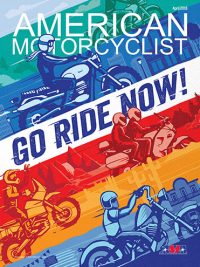American Motorcyclist April 2018
Ride To Good Hope
Battlefields, Rain And South African Adventure
► AMA members get exclusive access to American Motorcyclist every month! Join The AMA Today!

From left to right Forrie, Ahmed, Rick at 6,000 ft in Lesotho
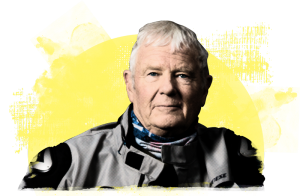
The Republic of South Africa—RSA—is the spectacular and fascinating country that sits at the foot of the continent of Africa. Framed east and west by the Indian and Atlantic Oceans and to the north by Namibia, Botswana, Zimbabwe and Mozambique, it’s big, too—the 24th biggest country on the planet, bigger than any country in Europe.
Famous for its wildlife, landscapes, coastline, vineyards, and, above all, for its diverse people, RSA is—despite its turbulent history—now safe for sensible travelers.
Nelson Mandela famously described RSA as a “Rainbow Nation,” and perhaps this remains the perfect description of a country of 58 million inhabitants and immigrants, speaking 11 official languages.
With my two buddies—Ahmed from Kuwait and Forrie from New Zealand—the plan was to ride 5,000 kilometers from top to bottom of this amazing country, “plus” Swaziland and Lesotho.
For bike rental, we used BMW-accredited SAMA (South African Motorcycle Adventures) for a self-guided tour. We chose our favorite bikes—two F800s and a GS1200—and for our route we picked a mix of dramatic landscapes, wildlife parks, battlefields and one of the best dirt roads on the planet.
From our far-flung homes we flew into Johannesburg, and SAMA drove us the short hop to its base in Pretoria. The following day we had a safety briefing and loaded our BMWs, each well equipped for touring with maps, satellite navigation and a route handbook.
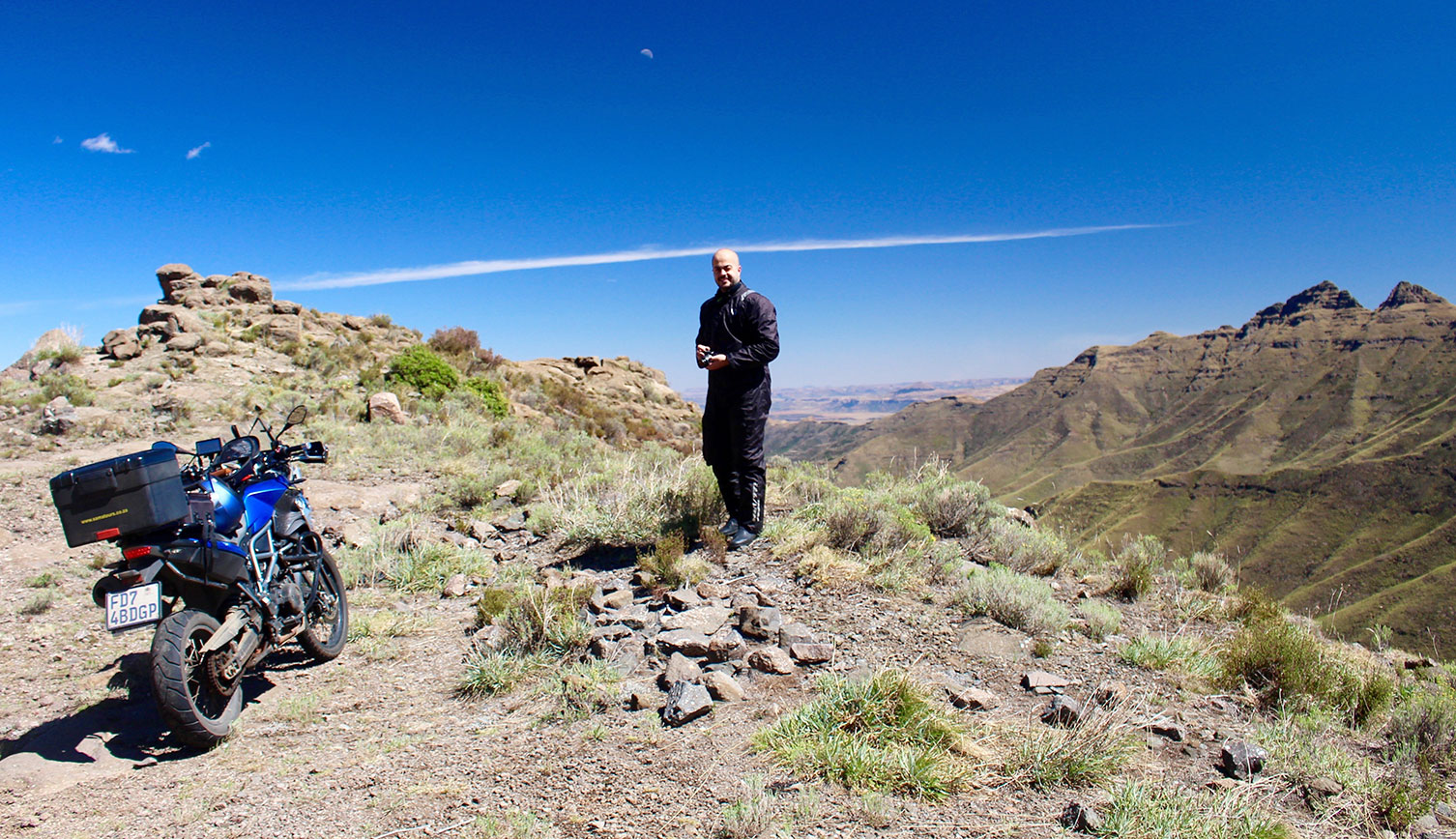
Ahmed pauses for a photo op with his BMW.
The Rain, The Park And Other Things
Our first day was an easy run north, but our fuel gauges soon had us navigating off-map in search of gas. Once cheaply topped up—we were constantly surprised how far our euros and dollars would go—the weather turned cold and we finished our uneventful first day in thick mist.
The mist was still hanging around the following morning, a pity, as the valley we rode through was, to quote from our handbook, “one of South Africa’s most spectacular.” But however much we disliked the mist, it was nothing compared to the torrential rainstorm that broke around midday, and which we swam through for the next six hours.
Clearly, they were having a prolonged dry spell, but I couldn’t help, selfishly, hoping this might last another couple of weeks. Well, my selfishness was punished that day, the rain so heavy we felt it through our jackets, and we were drenched within minutes. There seemed little point in stopping to change into our outer suits, and we just plodded on, hoping rain this heavy couldn’t last. Sadly, it did, and we arrived at our guesthouse pouring water out of our boots.
The next day was spent in Kruger National Park—motorbikes not allowed—an ideal time for our gear to dry out. SAMA organized a guided tour, the sun shone and we spend the day happily taking wildlife photographs, lucky enough to see a hyena stalking a herd of antelope.
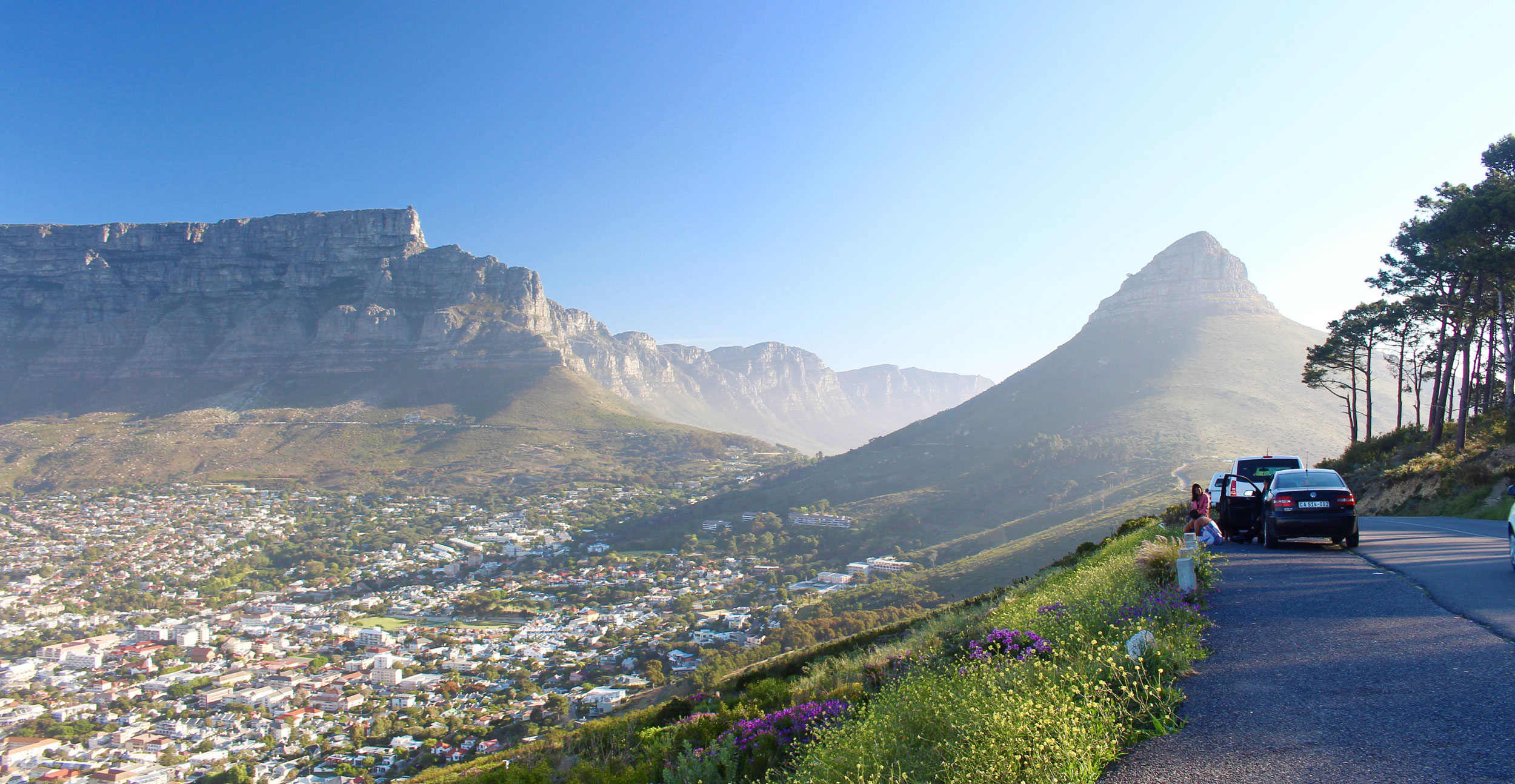
Cape Town and Table Mountain
Swaziland Culture
Next morning I ignored the blue skies, and—planning for rain—scrambled into my big yellow Aerostich riding suit. My sensible buddies checked the forecast on their phones and dressed in their regular gear. While we ate our bacon and eggs, the news told us the storm we’d just ridden through was the area’s “second heaviest rainfall since records began.”
Fortified by our superb breakfast, we had a lovely 300-kilometer ride across the border into Swaziland. This tiny landlocked country is the smallest in the Southern Hemisphere, about half the size of Maryland, and ruled by King Mswati lll, a man with so many wives he’s lost count. To be fair, the number keeps going up. Every year, the king chooses another bride from thousands of topless maidens in the “Reed Dance” ceremony.
As we rode the excellent roads through timber plantations, smiling children really did wave as we passed by. However, these smiles masked the reality that 70 percent of the population exists on less than $1 a day, a level of poverty hard to imagine.
Historic Battlefields
The next day also dawned cloudless blue, but my buddies insisted I wear the yellow suit as a good-luck, no-rain charm. We continued south, crossing back into RSA over a quiet border: nothing to report except waste bins celebrating the Reed Dance.
We headed to Isandlwana and Rorke’s Drift, eager to learn more about the great battles that were fought there. Every British schoolboy knows about Rorke’s Drift, even if he never saw the film “Zulu.” Here, in the most celebrated “victory” of the Anglo-Zulu war in the 1800s, a tiny British contingent of 139 soldiers successfully defended their outpost, holding off a 5,000 strong Zulu army.
Rather less celebrated is the defeat at Isandlwana, only a few miles away, where a British force of 1,300 men had camped under the imposing hill. They were equipped with modern weapons—breech loading rifles, field guns, even rockets—but were overwhelmed by a Zulu force of around 20,000 men, armed only with spears and shields. It remains one of the worst defeats suffered by the British in any war, a tribute to the will of an enemy, and the battlefield is littered with white stone cairns, each marking a pile of bones.
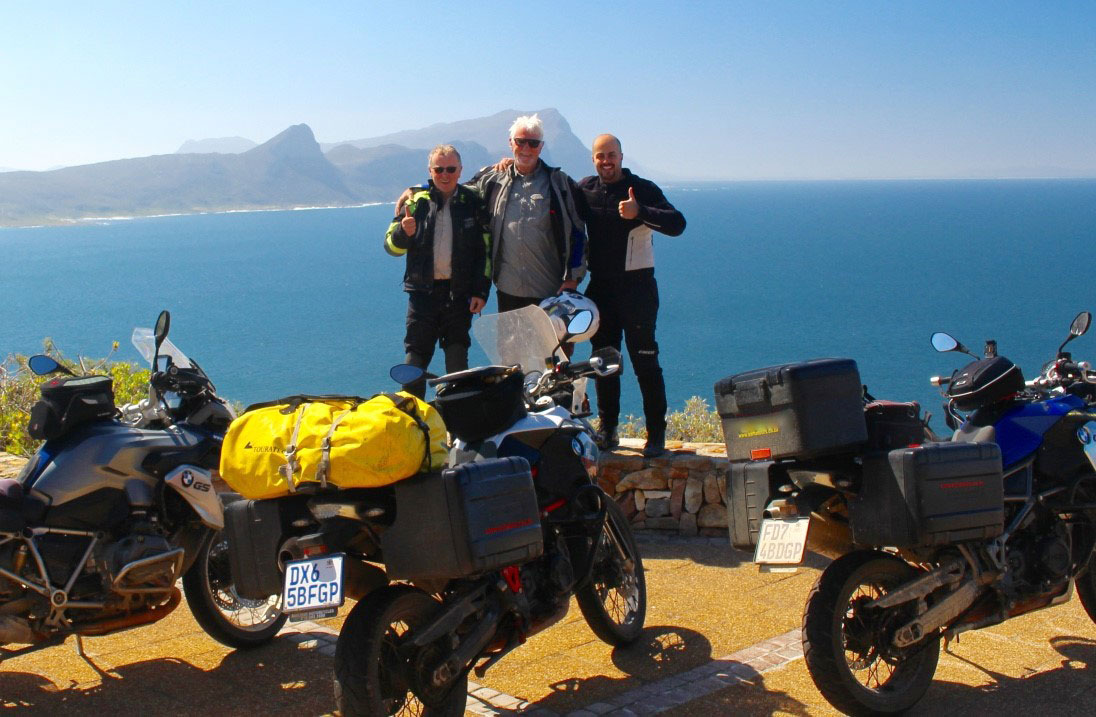
Rick, Forrie and Ahmed at the Cape
We left the battlefields and rode 400 kilometers northwest to Clarens, a delightful town on the edge of the Golden Gate National Park. We were staying for two nights, a chance to catch up on laundry and emails. The following day we unloaded our bikes and set off early to ride across another border, into Lesotho.
Lesotho: A Study In Contrast
Our first impression of this new country was the contrast between the beauty of the landscape and the poverty of the people. This is the world’s most mountainous nation, but with only one resource—water—hence the Lesotho Highlands Water Project, Africa’s largest engineering project.
We rode 250 kilometers to the dam, enjoyed the gorgeous roads and spectacular scenery, had lunch at the Dam Lodge, and zipped back to Clarens, a 500-kilometer ride, all the more enjoyable as we rode unloaded.
Challenging Passes, Rugged Roads
Following our “day off,” we loaded the bikes up again for another long run, 550 kilometers south, skirting Lesotho, aiming for its southern border and the famous Sani Pass. We were looking forward to this, one of our trip highlights, but good weather is essential and as we rode the last 75 kilometers on dirt, past giant boulders of the Drakensbergs, we anxiously watched the falling mists and hoped it would stay dry.
The Sani Pass has been called “The Mother of all African Mountain Passes,” a rock-and-gravel monster that tops out just short of 10,000 feet. Even dry, it’s only possible in a 4×4—local regulation not allowing motorcycles is sometimes waived—and the risks multiply when you realize the Sani is the only road into this corner of Lesotho.
And in the wet? The cross streams flood, ruts fill with mud, the trail becomes impossible, and the many wrecks and roadside crosses warn the over-confident.
I love motorcycling, but ask me to ride a deeply rutted, boulder strewn track with steep drop-offs, 1- to 3-degree gradients, no barriers and tight bends? It’s out of my league, and I planned to sit in a bouncy Land Cruiser, cuddling my camera, reveling in the astonishing views, happy to record the exploits of my more adventurous buddies.
Again, our good luck with the weather held up. I was in jeans and a tee, my big yellow suit taking no credit for the blue skies, and we set off knowing the pass was closed the previous day (mist) and closed the day before that (snow).
At first, the road seemed OK, and I thought maybe I could’ve ridden this. But, as we climb, it turned ugly, a combination of a very loose surface and ankle-deep ruts—Forrie described it as “rather technical.” Soon I’m hanging onto the Toyota’s grab handles, looking back at my buddies and wondering how they’re staying upright. When we stopped for photos, they pulled alongside and explained we were too slow, they must overtake and keep up their momentum.
So they disappeared in a shower of rocks and gravel, and we were reunited two hours and 10,000 feet later at Africa’s highest pub.
I regretted not attempting the Sani, but lacking the off-road skills of my buddies, it would have been a stupid decision, and I was content to be an observer of their extraordinary achievement.
Indian Ocean R&R
The following day, our ride had a different feel. We dropped south out of the mountains for a long run of 600 kilometers to the coast. The conditions were so good—excellent roads and more blue skies—that Ahmed’s puncture caught us by surprise. Probably as a result of the Sani track, his rear tire went flat, luckily with only 50 kilometers to go. SAMA responded quickly, a pickup truck was soon on the scene, and that evening we paddled bare-foot in the Indian Ocean.
On the road once more, rested and under blue skies—since that early rainstorm the weather had been perfect—we continued west, occasional signs for Cape Town reminding us our ride is almost over. We stayed that night in the pretty seaside town of Knysna, home to a motorcycle museum, where I sat on a 1958 Tiger Cub. It could’ve been mine, except mine was silver and black.
“Sex” Shop, Whale Trumpet
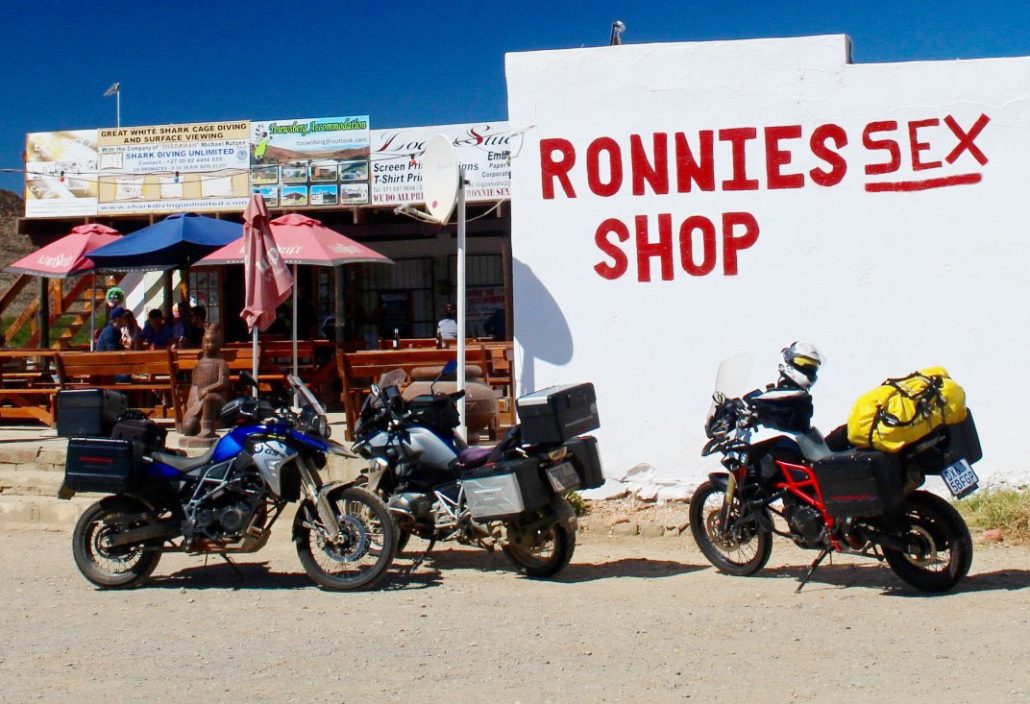
Ronnies Sex Shop is a coffee shop with a name intended to arouse curiosity.
Next, we enjoyed a brief excursion through the fabulous passes of the Swartberg Mountains, an easy run of 150 kilometers, before swooping back down to the coast the next day, with a brief photo stop at Ronnies Sex Shop.
The story goes that the owner built this place, miles from anywhere, as a coffee stop, but nobody stopped. So he added the extra word, and now everybody stops. Nice coffee, but there’s no Ronnie, and certainly no sex.
Our aim that day was to reach Cape Agulhas, the southernmost tip of Africa, a rocky point where the cold Atlantic Ocean meets the warm waters of the Indian.
Wrapping Up The Ride
The next day was our last on the bikes—and still the sun shone! We set off early for Cape Town and the end of our ride, travelling the most spectacular coast we’ve yet seen, all the way to the legendary Cape of Good Hope.
This was a ride we didn’t want to end. The smell of the ocean was wonderful, and we loved the tumbling waterfall of clouds off the coastal mountains. Near the Cape—it was a Sunday—the traffic built up and the gorgeous spring weather brought out hundreds of bikers. Infected by this holiday mood, we winkled our way to the Cape and found a great spot to pose. It felt like the end of the world—it’s virtually the end of our ride—and a friendly bus driver took a snap.
All that remained was to ride the last few kilometers north to Cape Town.
On our last night, we enjoyed a blow-out meal overlooking the busy harbor, and reflected on our 5,000 kilometer ride.
Next morning, we did a ton of those back-slapping man hugs, and flew off for home.
And it rained.
Rick Wheaton is an AMA member who writes about motorcycling and touring the world over.

